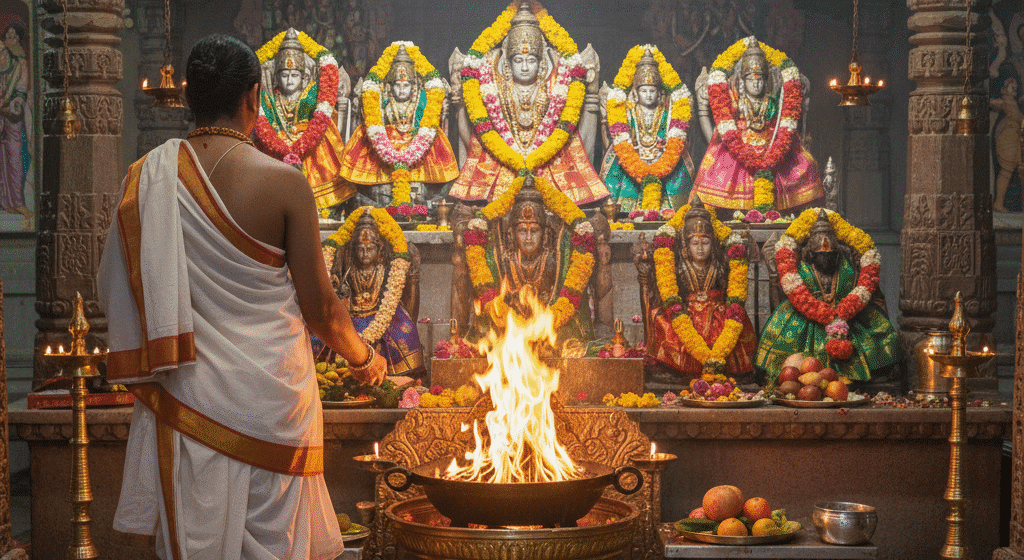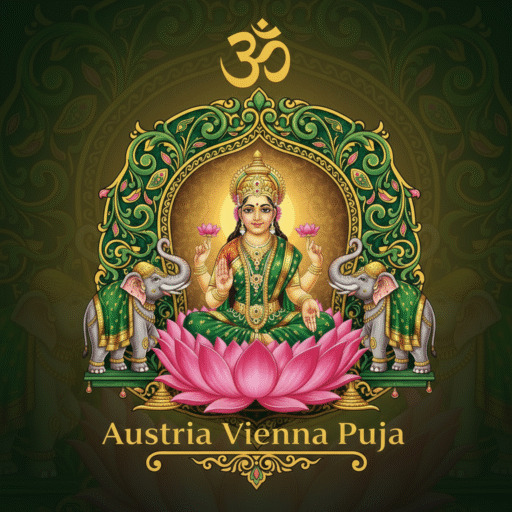
Homa
Note: Travel and accommodation expenses are to be paid extra .

Note: Travel and accommodation expenses are to be paid extra .
Homam, also known as Havan or Yajna, is an ancient Vedic ritual rooted in the Vedas and Upanishads where sacred substances are offered into a consecrated fire. This ceremony embodies the principle of Yajna (sacrifice) described in the Bhagavad Gita as one of the primary paths to divine realization. Fire, recognized as Agni Deva (the fire deity), serves as the intermediary between the material and divine realms, transforming earthly offerings into subtle spiritual energy.
The Chandogya Upanishad describes Agni as the gateway through which intentions ascend to cosmic consciousness, making this ritual not merely a ceremonial practice but a profound spiritual technology refined over millennia. When performed with authentic knowledge and sincere intention, Homam creates transformative effects extending far beyond the immediate participants.
Explore Vedic ritual philosophy: Yajna – Britannica
The origins of this ceremony are embedded in the Rig Veda, where Yajna is described as the cosmic principle underlying creation itself. The Taittiriya Upanishad states that all existence emerged from sacrifice, and through conscious participation in ritualized offerings, individuals align themselves with universal law (Rta). This is not performance for reward, but rather active participation in the fundamental order of existence.
The Yajurveda details specific procedures for conducting these ceremonies, emphasizing that efficacy depends on the consciousness and purity of intention of those performing it, not merely the mechanical execution of steps. This distinction proves crucial: the ritual remains valid only when accompanied by sincere spiritual aspiration and mental clarity.
A qualified priest brings years of training in understanding these subtle principles, ensuring that each element—from timing calculations to mantra selection—aligns with authentic Vedic standards and the participants’ spiritual intentions.
In Vedic philosophy, fire possesses inherent purifying properties at both gross and subtle levels. When materials are offered to Agni, the ritual accomplishes what the Katha Upanishad describes—the transcendence of limitations through conscious participation in cosmic principles. This purification extends to the participant’s consciousness, clearing mental and emotional obstructions that impede spiritual progress.
Fire does not merely consume physical matter; rather, it transforms the nature of what is offered. The smoke carries the essence of offerings toward the divine realm, while the residual ash represents the purified remainder. Participants witness this transformation directly, creating profound psychological and spiritual impact.
The ceremony creates a sanctified field. The Mantra Yoga texts explain that the resonance of Sanskrit mantras, combined with the transformative power of fire and the intersectionality of participants, generates a field of coherent spiritual energy. This is why traditional practice emphasizes the purity of the ritual space and the integrity of those conducting it.
The physical arrangement, sacred geometry of the fire altar, selection of materials, and precise timing all contribute to establishing an environment conducive to spiritual transformation. Many participants report experiencing profound shifts in consciousness during authentic ceremonies conducted by experienced priests.
Rather than viewing deities as separate entities demanding appeasement, Vedantic philosophy understands them as manifestations of universal principles. Performing a specific Homam ceremony aligns the participant’s consciousness with that particular cosmic principle—a Lakshmi ceremony tunes awareness to principles of abundance and prosperity, a Maha Mrityunjaya ceremony to vitality and transcendence of limitation.
This understanding removes superstition while preserving profound spiritual truth. The ceremony works not through supernatural intervention but through the participant’s conscious attunement to principles that are always present and eternally active.
When entering a new home, this ritual purifies the space and aligns its subtle energies with the inhabitants’ consciousness. The Vastu Shastra texts describe how conscious ritual sanctification establishes harmony between inhabitants and their environment. In modern Austria and Europe, families perform this ceremony in new apartments, houses, or offices, creating a spiritually auspicious foundation for their new chapter.
Based on Vedic astrology, this multi-deity ceremony addresses planetary influences. Rather than suggesting planets literally determine fate, Jyotish philosophy understands planetary positions as reflections of karmic patterns. The ceremony assists in conscious realignment with inherent potential and addresses specific life challenges through appropriate spiritual practices.
Drawn from the Rig Veda (7.59.12), this 2000-year-old mantra invokes protection and transcendence of mortality consciousness. It addresses both physical well-being and the deeper spiritual aspiration for freedom from limitation. Families perform this ceremony when facing health challenges, major life transitions, or seeking to deepen spiritual consciousness.
Ganesha represents the principle of removing obstacles and facilitating beginnings. This ritual is performed before significant undertakings—new business ventures, educational pursuits, relocations, or major decisions—to establish clarity and remove impediments to success.
The ritual space is purified through intention and natural elements. Participants bathe and wear clean clothing, symbolizing mental and emotional preparation. An experienced priest determines the most auspicious timing based on lunar and stellar positions (Muhurat). This consultation ensures the ceremony aligns with natural cycles of optimal receptivity and spiritual potency.
The priest evaluates the participants’ circumstances, intentions, and astrological configurations to customize the ceremony appropriately. This personalization distinguishes authentic practice from mechanical ritual performance.
Each offering carries symbolic meaning derived from Vedic texts. Ghee represents purity and nourishment. Grains embody prosperity and sustenance. Specific herbs possess both therapeutic and symbolic properties—turmeric for purification, sandalwood for cooling the mind, specific woods for their aromatic and energetic qualities. Every element serves a purpose grounded in thousands of years of Vedic knowledge.
The selection of materials reflects the ceremony’s specific intent while honoring ecological responsibility. Traditional practice emphasizes using natural, sustainable materials, aligning spiritual ceremony with environmental consciousness.
The sacred fire is kindled with specific procedures passed down through priestly lineages. As materials are offered, Sanskrit mantras are chanted—not as mechanical repetition, but as vehicles of consciousness. The Vedas describe the human voice as a transmitter of cosmic order when aligned with sacred sounds. The combination of mantra, fire, and intention creates the transformative environment essential to the ceremony’s efficacy.
Participants observe flames rising, smoke ascending, and the transformation of offerings. This direct witnessing makes the abstract principle of transformation concrete and personally impactful.
Sanskrit mantras embody vibrational patterns that, according to Tantra texts, directly influence consciousness. Mantra Shastra teaches that specific sounds produce specific effects in the subtle body and mind. Collective chanting amplifies this effect, creating resonance among participants and elevating the collective consciousness.
An experienced priest chants with precise pronunciation, knowing that the subtle vibrations matter profoundly. This is why learning from qualified teachers remains essential—even small mispronunciations diminish effectiveness.
The presence of these ceremonies in diaspora communities reflects the universal nature of spiritual principles. In Austria and throughout Europe, Hindu communities and seekers from all backgrounds perform these rituals to address contemporary challenges—work transitions, family harmony, health concerns, and spiritual development.
These ceremonies adapt while maintaining essential integrity. A Homam performed in Vienna carries the same profound principles as one in Varanasi, yet its language explanations, timing considerations, and community composition reflect its new cultural context. This adaptability demonstrates that spiritual truth transcends geographical boundaries while respecting local conditions.
Discover our Homam services:
Homam Services
Participation requires no prior experience or religious affiliation. Individuals are invited to approach the ceremony with sincere intention and openness. It is recommended to consult with an experienced priest who can explain the specific ritual’s purpose and guide participants in aligning their consciousness with the ceremony’s intent.
Bringing offerings—flowers, fruits, or clarified butter—symbolizes participation and respect. However, the greatest offering is mental clarity and genuine aspiration for personal and collective well-being. Even if unfamiliar with Vedic traditions, sincere seekers find profound meaning through direct participation.
What is the significance of fire in these ceremonies?
According to the Vedas, fire (Agni) represents the principle of transformation and the gateway between material and spiritual dimensions. Offerings rendered into Agni are transformed from physical matter into subtle energy that reaches the divine realm. This represents an actual shift in the nature of the offering through conscious ritual rather than mere metaphor.
Can anyone participate regardless of background?
Absolutely. The Vedas emphasize that sincere spiritual aspiration is the only requirement. While traditionally organized by temples and community centers, ceremonies welcome participants regardless of background, religion, or experience level.
What offerings are typically used?
Common offerings include ghee (purification and nourishment), grains (prosperity), coconut (fertility and abundance), sesame seeds (well-being), and specific herbs selected for their inherent properties and the ceremony’s specific intent. An experienced priest advises which materials are appropriate for each situation.
How does the ceremony affect the surrounding environment?
The smoke carries medicinal and aromatic properties of the herbs burned. Traditional practice emphasizes using natural, sustainable materials, aligning spiritual practice with ecological responsibility. The Vedas describe the ceremony as beneficial to the atmosphere when performed correctly.
How is auspicious timing determined?
The optimal timing (Muhurat) is calculated using Vedic astrology, considering lunar phases, star positions, and planetary configurations. An experienced priest consults these calculations to ensure the ceremony aligns with natural cycles of maximum receptivity and efficacy. This astrological dimension significantly enhances the ceremony’s effectiveness.
What is the connection between these ceremonies and Ayurveda?
Both are Vedic sciences addressing different dimensions of existence. While Ayurveda works through dietary and herbal means on the physical body, ceremonies operate through subtle energetic and consciousness-based principles. Both aim at restoring harmony and balance within individuals and their environments.
For deeper understanding of Yajna and its philosophical foundations, consult Yajna – Britannica which provides comprehensive information on the Vedic ritual philosophy underlying these practices. To explore the astronomical and astrological principles determining ritual timing, Encyclopedia of Religion describes Muhurat calculations and their spiritual significance across Hindu traditions.
Britannica Resources
https://www.britannica.com/topic/Veda
https://www.britannica.com/topic/Dharma-shastra
https://www.britannica.com/topic/Sanskrit-language
https://www.britannica.com/biography/Panini-Indian-grammarian
https://www.britannica.com/topic/Hinduism/Practice
https://www.britannica.com/topic/Advaita-school-of-Hindu-philosophy
https://www.britannica.com/topic/Vedic-religion
Stanford Encyclopedia
https://plato.stanford.edu/entries/logic-india/
https://plato.stanford.edu/entries/god-ultimates/
Academic Journals & Databases
https://jstor.org
https://pdcnet.org
https://ijhp.bgrfuk.org
Oxford Centre for Hindu Studies
https://ochs.org.uk
https://ochsonline.org
Government & Archive Resources
Research Papers
https://papers.ssrn.com
Educational Institutions
https://vedanet.com
https://vedicscience.net
https://bhishmaiks.org
https://vedicwellnessuniversity.com
Additional Academic Resources
https://ijnrd.org
https://takshila.org.in
https://wisdomlib.org
https://cambridge.org
https://academic.oup.com
https://pmc.ncbi.nlm.nih.gov
Homam represents a living connection to humanity’s most ancient spiritual wisdom. Through conscious participation in this sacred ceremony, individuals engage directly with principles of transformation, purification, and alignment with cosmic order—principles that transcend time and culture while remaining profoundly relevant to contemporary spiritual seeking and personal development.
Whether addressing specific life challenges, marking important transitions, or deepening spiritual practice, authentic ceremonies conducted by experienced priests create lasting transformation extending far beyond the ceremony itself.
Connect for your ceremony:
Sahadev Pandit Services
